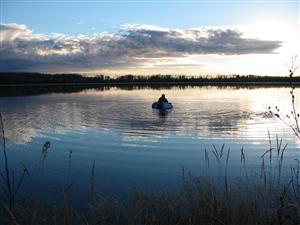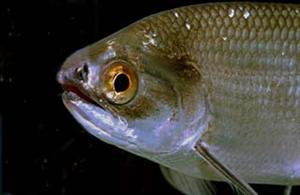Fisheries Resource in the Oil Sands - an overview
Alberta is home to 63 species of fish, including eight introduced, non-native species. Only 18 of these species are targeted in recreational or commercial fisheries for sale as food, while the remaining 45 species are small-bodied fish that are preyed upon by birds, mammals, and larger fish (ASRD 2008c).
Alberta’s game fish are classified by biologists into two groups, differentiated by the water temperature preferred by each group. The cold-water fishes of Alberta belong to the trout and salmon family (Salmonidae), and include the lake and mountain whitefish, Arctic grayling, and several species of trout. These fish prefer water temperatures between 5 and 18 degrees Celcius. Alberta’s cool-water fishes include walleye, yellow perch, goldeye, lake sturgeon, sauger, northern pike, and burbot. These fish prefer water temperatures between 10 and 25 degrees Celcius, although there is variation in the temperatures that species can tolerate and require for spawning (ASRD 2002b).
Fishes of Alberta are found in lakes, streams, rivers, reservoirs, and wetlands. The province is divided into three zones for fish management, including the Eastern Slopes zone (the Rocky Mountains and foothills), the Parkland Prairie zone (the southeastern quarter of the province), and the Northern Boreal zone. The Northern Boreal zone covers the boreal forests of central and northern Alberta, and includes numerous lakes and watercourses draining the Athabasca, Peace, and Hay river basins. Habitat in the boreal region includes shallow, algae-covered lakes and muddy, sluggish creeks as well as the larger rivers and lakes (Joynt and Sullivan 2003). The area supports populations of yellow perch, northern pike, walleye, lake whitefish, lake trout, Arctic grayling, suckers, and numerous other species. Because of the long winters and relatively cool summers, species in the boreal region grow slowly relative to species elsewhere in North America. Species in this region are also well-adapted to a variety of climatic and water quality conditions, allowing them to make use of the range of habitats found in the boreal region (Joynt and Sullivan 2003).
Alberta contains only 800 fish-bearing lakes. In comparison, there are 94,000 fish-bearing lakes in Saskatchewan, 110,000 in Manitoba, and 250,000 in Ontario. An additional 300 waterbodies (ponds, reservoirs, and normally non-fish-bearing lakes) in Alberta are stocked annually with rainbow trout (Park 2007). Nonetheless, with an estimated 300,000 anglers and a total of 3.2 million “fishing days” per year (estimated in a 2005 survey), fishing pressure on each lake in Alberta is very high (Park 2007). In addition to angling, there are 800 commercial fishing operators in Alberta harvesting fish from over 100 lakes, and many aboriginal domestic (subsistence) fisheries in remote northern lakes, including Lake Athabasca. Given the amount of fishing pressure in Alberta lakes and rivers, management strategies for each waterbody and species are established in an effort to maintain consistent population levels that meet the needs of all resource users.
For more information:
Alberta Fish and Wildlife Website










